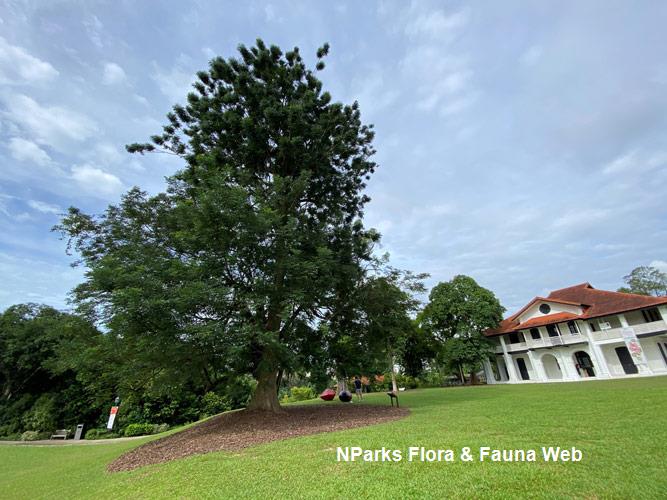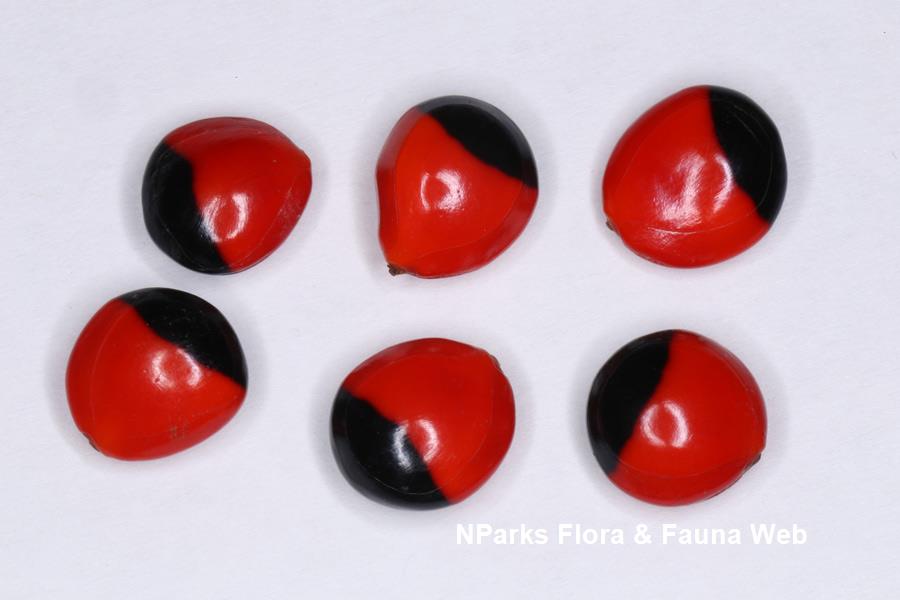_lowres.jpg)
Back
Adenanthera malayana Kosterm. subsp. malayana
| Family Name: | Fabaceae (Leguminosae) |
Adenanthera malayana subsp. malayana is a endangered tree in Singapore. It can reach up to 45 m and have bipinnate leaves. The fruit pod twists into a spiral and splits open when ripe. Each fruit contains about 10 red and black ornamental glossy seeds.
Name
Classifications and Characteristics
| Plant Division | Angiosperms (Flowering Seed Plants) (Dicotyledon) |
|---|---|
| Plant Growth Form | Tree |
| Lifespan (in Singapore) | Perennial |
| Mode of Nutrition | Autotrophic |
| Plant Shape | Irregular |
| Maximum Height | 45 m |
Biogeography
| Native Distribution | Peninsular Malaysia, Singapore and Sumatra |
|---|---|
| Native Habitat | Terrestrial |
| Preferred Climate Zone | Tropical |
| Local Conservation Status | Native to Singapore (Endangered (EN)) |
Description and Ethnobotany
| Growth Form | It is a tree, up to 45 m tall, and sometimes with buttresses, up to 1.2 m high. |
|---|---|
| Foliage | Leaves are green, compound (bipinnate) and arranged alternately. Each leaf comprises of 2 to 3 pairs of pinnae. Each pinna has (2-) 3 - 5 leaflets on each side. Leaflets are ovate to elliptic-suborbicular ( 1.8 - 5 (-8) cm long and 1 - 4 (-5) cm wide). The leaflet base is slightly asymmetrically cuneate while the tip is rounded or notched (emarginate) or mucronulate. The upper surface of the leaflets does not have microscope pellucid dots. |
| Flowers | Flowers occur in a cluster as a raceme inflorescence, about 8 - 15 cm long. Flower is tiny and has white petals that turn yellow. Each flower has 10 stamens which are white and turning yellow with age, as well as an ovary with scattered apressed hairs. |
| Fruit | Fruit is a pod which twist into a spiral before splitting. Reaching up to 8 - 15 cm long, it turns purplish black and split open when ripe. Each fruit contains about 10 seeds within. The seeds are glossy red and black, obovoid or orbicular (0.65 - 0.8 cm wide) with distal black spot. |
| Habitat | It grows in rainforests and on rocky and sandy soils up to 900 m altitude. |
| Associated Fauna | Flowers are pollinated by insects. The bright red seeds are eaten by birds which mistake them for juicy red fruits. |
| Cultivation | It can be propagated by seeds. |
| Ethnobotanical Uses | Cultural / Religious: There are currently 1 individual of Adenanthera malayana subsp. malayana listed as Heritage Trees in Singapore. o find out more about this tree, please visit the Heritage Tree Register. |
Landscaping Features
| Desirable Plant Features | Ornamental Seeds |
|---|---|
| Landscape Uses | General, Parks & Gardens, Small Gardens, Shade Providing Tree / Palm |
Fauna, Pollination and Dispersal
| Pollination Method(s) | Biotic (Fauna) |
|---|
Plant Care and Propagation
| Light Preference | Full Sun, Semi-Shade |
|---|---|
| Water Preference | Moderate Water |
| Plant Growth Rate | Moderate |
| Rootzone Tolerance | Moist Soils, Well-Drained Soils, Fertile Loamy Soils |
| Propagation Method | Seed |
Foliar
| Foliage Retention | Evergreen |
|---|---|
| Mature Foliage Colour(s) | Green |
| Foliar Type | Compound |
| Foliar Arrangement Along Stem | Alternate |
| Foliar Attachment to Stem | Petiolate |
| Foliar Shape(s) | Non-Palm Foliage |
| Foliar Venation | Pinnate / Net |
| Foliar Margin | Entire |
Floral (Angiosperm)
| Flower & Plant Sexuality | Bisexual Flowers |
| Flower Colour(s) | White, Yellow / Golden |
|---|---|
| Flower Grouping | Cluster / Inflorescence |
Fruit, Seed and Spore
| Mature Fruit Colour(s) | Purple |
|---|---|
| Fruit Classification | Simple Fruit |
| Fruit Type | Dehiscent Dry Fruit , Legume / Pod |
References
| References | Nielsen, I.C. & & Hopkins, H.C.F. (1992). Mimosaceae (Leguminosae-Mimosoideae). In de Wilde, W.J.J.O et al (eds.) Flora Malesiana. Series 1 Vol. 11 (1). Pp. 1–226. Leiden: Rijksherbarium/Hortus Botanicus, Leiden University |
|---|
Image Repository
Others
| Master ID | 29186 |
|---|---|
| Species ID | 3495 |
| Flora Disclaimer | The information in this website has been compiled from reliable sources, such as reference works on medicinal plants. It is not a substitute for medical advice or treatment and NParks does not purport to provide any medical advice. Readers should always consult his/her physician before using or consuming a plant for medicinal purposes. |



_lowres.jpg)
_lowres.jpg)
.jpg)